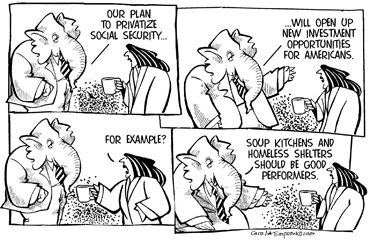
Departments


|

Forces are gathering in Washington to make
sweeping changes in Social Security, with the White House leading the
charge. Using his “mandate victory” of 2%, President Bush
is making plans to privatize Social Security to the determent of America’s
workers. This is building up to be one of the most important battles the
working class has faced in years. It will take a concentrated effort to
turn back the billions that corporations are throwing into the ring to
break down the rights of workers.
President Bush’s Social Security scheme will costs $2 trillion and
would entail massive cuts in promised benefits. While workers see cuts,
bankers and brokers will live fat on the windfall they will receive at
the expense of workers. The Washington Post reports that "a retiree
in 2075 would receive 54 percent of the benefit now promised."
Education and information is the key to wading through the misinformation
that the White House is using to sale this tainted bill of good. We
need to contact our elected representatives and tell them to stop the
White House from dismantling Social Security!
History of Social Security
For over 60 years Social Security has been the building block for taking
care of America’s workers. It provided workers with a basis for
saving for retirement, while protecting workers with a safety net in the
event they became disabled and were no longer able to provide for their
families.
Prior to the current system, families were left to provide care for the
aging loved ones. President Franklin Roosevelt saw the growing need for
a plan to care for America’s aging and developed a commission to
study the issue. On August 14, 1935 the Social Security Act was signed
into law, putting a plan in place to cover America’s aging workers.
Over the next 15 years amendments were passed to strengthen program for
the future. On August 1, 1956, the Social Security Act was amended to
provide benefits to disabled workers aged 50-65 and disabled adult children.
Over the next 2 years, Congress broadened the scope of the program, permitting
disabled workers under age 50 and their dependents to qualify for benefits,
and eventually disabled workers at any age could qualify.
The decade of the 1960s brought additional changes to the Social Security
program. Among the most significant was a provision in the Amendments
of 1961 lowering the age at which men are first eligible for retirement
benefits to 62 (women previously were given this option in 1956).
The most significant change involved the passage of Medicare. Under Medicare,
health coverage was extended to Social Security beneficiaries aged 65
or older (and eventually to those receiving disability benefits as well).
Nearly 20 million beneficiaries enrolled in Medicare in the first 3 years
of the program. SSA would continue to have responsibility for all aspects
of the Medicare program until a 1977 reorganization created the Health
Care Financing Administration (HCFA). HCFA assumed administrative responsibility
for Medicare at that time.
|

Social
Security reform revisited
By Amy Fagan
Washington Post
09-19-05
Help Still Needed On Social Security
Social
Security Battle Not Over Yet
Shifting Risk
Workers today near retirement more vulnerable and with lower pensions
July 21, 2005 By Lee Price Economic Policy Institute
House
GOP Plan Swaps Benefits, Accounts
By DAVID ESPO, AP Special Correspondent LA Time
July 18, 2005
UAW Social Security Update
Bush
Backs Soc. Sec. Bill Without Accounts
Associated Press - 6/21/2005
Social
Security may be just the beginning
By Gail Russell Chaddock | The Christian Science Monitor
In Overhaul of Social Security, Age Is the Elephant in the Room
By ROBIN TONER and DAVID E. ROSENBAUM New York Times
Published: June 12, 2005
Who
Gets What: Simple, Yet so Complicated
By Richard Wolf
USA TODAY
Retirement
Income: The Crucial Role of Social Security
Economic Policy Institute - 5/25/2005
UAW Action Alert To Stop Privatization of Social Security
Bush's
Plan for Retirement Leaves G.O.P. in a Quandary
New York Times - 5/23/2005
Why pensions are becoming even scarcer
Christian Science Monitor - 5/16/2005
John
Podesta: Progressive Indexation
Center for American Progress - 5/16/2005
Hubbard:
Bush Plan May Shrink Survivor Aid
Associated Press - 5/12/2005
Many
Low-Income Beneficiaries Would Face Social Security Benefit Cuts Under
President's Plan
Center on Budget and Policy Priorities - 5/10/2005
Krugman:
The Final Insult
New York Times - 5/9/2005
Democrats
stand pat on
Social Security
Boston Globe - 5/8/2005
GOP,
Like Companies, Want Workers to Carry the Safety Net
Los Angeles Times - 5/8/2005
U.S.
Warns A.F.L.-C.I.O. on Protests About Social Security
New York Times - 5/5/2005
Not
rich? Not poor? Watch out
Boston Globe - 5/4/2005
A
Gut Punch to the Middle
By PAUL KRUGMAN
Published: May 2, 2005
Social
Security Privatization: Abandoning Family Values
by Radha Chaurushiya and Christian E. Weller
April 27, 2005
Editorial:
How About A Plan?
Newsday 04/12/05
A
Misinformed Public: The Real Problem
Center for Economic and Policy Research - 4/12/05
Bush
Counts on Thomas to Rescue Lagging Social Security Effort
Bloomberg 04/14/05
The Point of No Returns
Libby Perl, The Century Foundation, 3/30/2005
The Social Security 'bait and switch'
Dan Hofrenning
April 5, 2005
Click Here For More Headlines On Social
Security
|
|




